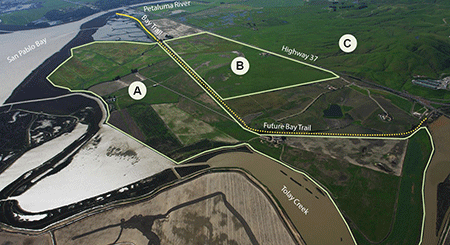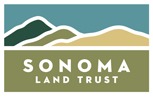SEA CHANGE PRESS KIT
Redrawing the map of San Francisco Bay
PRESS RELEASE
FAQ
PHOTO/VIDEO
MEDIA COVERAGE
CONTACT:
Sheri Cardo
Director of Communications
(707) 526-6930 x111
sheri@sonomalandtrust.org
ON OCTOBER 25, SONOMA LAND TRUST WILL BREACH SEARS POINT LEVEE TO CREATE 1,000 ACRES OF TIDAL MARSH
SANTA ROSA, CALIF., October 25, 2015
A major transformation is coming to the northern coast of San Francisco Bay. After 10 years of planning and raising $18 million, on Sunday, October 25, Sonoma Land Trust will breach the levee along the bay at Sears Point Ranch (located just south of the Highway 37/Lakeville Highway intersection) to allow salt water to fill the recently constructed 1,000-acre tidal marsh basin. This area will begin to evolve to tidal marsh, much as it was 140 years ago before being diked off from the bay.
This new tidal marsh, along with enhancing the entire bay ecosystem, will offer the following significant benefits:
- providing habitat for endangered and native species,
- capturing carbon,
- filtering pollutants, and
- buffering our infrastructure (highway and railroad) from the rising seas and storm surges expected as a result of climate change.
A new 2.5-mile-long section of the San Francisco Bay Trail on top of the new levee will also provide some of the best access to the bay in Sonoma County. The trail, and a kayak ramp, will open to the public by early 2016. This restoration has benefited from lessons learned from previous projects — and from nature itself — and incorporates several innovations to reduce the cost and increase the pace at which the marsh is expected to grow.
“We have turned a new page in the history of wetlands at San Pablo Bay,” says Dave Koehler, Sonoma Land Trust executive director. “Returning the tides to Sears Point restores health to a natural resource that is vital to our future. The Sea Change event is a celebration for the thousands of people who have contributed to this project, rolling up their sleeves alongside resource professionals to accomplish one of the largest tidal marsh restoration projects in the Western United States.”
“Tidal wetlands are natural infrastructure that help protect our shoreline,” says Janelle Beland, California Undersecretary for Natural Resources. “This project is a great example of how we can work in partnership with nature as we adapt to rising sea levels.”

A = Nearly 1,000 acres of future tidal marsh connected to the earlier Sonoma Baylands restoration site in the background;
B = Separated from the tidal marsh by the railroad track and the new habitat levee, this area will be a focus for seasonal wetland enhancement; and
C = Sears Point uplands, nearly 1,000 acres of grasslands, seasonal wetlands and riparian drainages. Photo by Robert Janover.
SEA CHANGE events on October 25
In the morning (starting at 9:30am), a private brunch and program will be held for elected officials, project partners, wildlife agencies and key contributors to the project, followed by the levee breach at noon. Among others, speakers will include U.S. Representative Mike Thompson, State Assemblymember Lois Wolk, and Greg Sarris, Tribal Chairman of the Federated Indians of Graton Rancheria.
In the afternoon, the public is invited to witness the returning of the tides from 2—6pm. Participants may visit the newly-breached levee site to watch the waters rushing through and explore the future 2.5-mile addition to the San Francisco Bay Trail. Native seed packets will be distributed so that attendees can help to seed the new tidal marsh. This rare opportunity is offered free of charge and pre-registration is required at www.sonomalandtrust.org.
It’s all about partnerships
Numerous federal, state and local agencies and organizations have been involved in this massive project. Ducks Unlimited has been a key partner in permitting, final design, construction management and funding.
“This transformation from hay fields back to historic tidal marsh will be an incredible benefit for the birds, fish and people of the Bay Area,” says Ducks Unlimited regional biologist Renee Spenst. “Ducks Unlimited is honored to have been involved in nearly every step of this large and complicated project that encompassed the best available science, technically challenging design and construction conditions, as well as a fundraising effort that sets a new model for large and complex conservation projects.”
“We are very grateful to have had the benefit of working with so many of the best minds around the bay on this project,” says Sonoma Land Trust’s Baylands program manager Julian Meisler. “We are a united community all working toward the common goal of a functioning tidal ecosystem.”
History of this land
Fortunately, unlike the other counties around San Francisco Bay, farmers along Sonoma County’s bayshore never developed their lands that had been diked in the mid-1800s, but used them instead to grow oat hay and graze cattle. However, in 2002, the Federated Indians of Graton Rancheria announced plans for building a casino on the ranch. Once tribal leaders recognized the environmental sensitivity of this land and its significance to their history, the Tribe changed its plans and donated their option to purchase the property, valued at $4 million, to Sonoma Land Trust.
That donation kick-started a $17 million campaign to buy the 2,237-acre Sears Point Ranch, which was achieved in 2005; since then, $18 million has also been raised to restore 1,000 acres of the ranch to tidal marsh. When the project is completed by the end of this year, it will be transferred to the U.S. Fish and Wildlife Service and become part of the San Pablo Bay National Wildlife Refuge.
“We are very excited to be joining Sonoma Land Trust in celebrating the return of the tides to these lands,” says Anne Morkill, manager of the San Francisco Bay National Wildlife Refuge Complex. “The Land Trust has been a key partner in helping the U.S. Fish and Wildlife Service achieve its mission by acquiring and restoring lands for the benefit of wildlife and the enjoyment of the public.”
The breach itself
With the help of an excavator, a 285-foot-wide breach will be created at high tide that will fully connect the project site to the bay. The water is expected to fill the tidal basin within 24 hours. Then, since tidal marshes form over long periods of time, it will take two to three decades to fill in with vegetation. In the meanwhile, waterfowl and other birds will fill the basin with flight and song.
“We are literally changing the map of the bay with this project,” says Meisler. “That’s important not because we are trying to go back in time, but rather, because we all depend on a functioning bay. It is vital to our safety, our economy, and for all the wildlife who call it home. This is our legacy and it’s wonderful to have one of which we, as a community, can be proud.”
FAQs
Previous media coverage
ABC News
Press Democrat
Sonoma News
About Sonoma Land Trust
Sonoma Land Trust believes land is the foundation of our economy and our community’s health and well-being. Since 1976, Sonoma Land Trust has preserved nearly 50,000 acres of scenic, natural, agricultural and open land for future generations, and is accredited by the Land Trust Accreditation Commission. For more information, please visit www.sonomalandtrust.org.
CONTACT:
Sheri Cardo
Director of Communications
(707) 526-6930 x111
